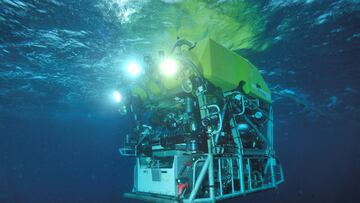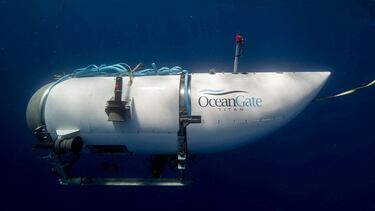Titanic expedition: What’s the difference between a submersible and a submarine?
We explain why the OceanGate tourist vessel that disappeared with a five-man crew on board is classed as a submersible, rather than a submarine.

Hope is fading for the five crew members of the OceanGate vessel Titan which lost contact with its mothership on Sunday and vanished without trace 3,800 metres beneath the Atlantic Ocean. A rescue/recovery operation is underway with the Canadian military and US Coast Guards combing the area, with the slim possibility that the vessel might have surfaced, although that seems unlikely as all of those on board had smartphones with them and would have messaged for help by now.
You might also enjoy
Rescue workers are battling against the clock as it is estimated that Titan’s oxygen reserves will run out on Thursday morning. Contact with Titan was lost on Sunday just under two hours after it began its dive to the wreckage of doomed passenger liner, RMS Titanic.
Titan’s mission was expected to last approximately ten hours but contact with its mothership MV Polar Prince, with whom it relied on for navigation information, was lost almost two hours after it had submerged. Since then, its location and the fate of those on board, is not known.

A number of hypotheses as to Titan’s fate
Prospects that the five crew members could be alive are slim. There is a high possibility that Titan suffered some kind of catastrophic failure - eg. either its carbon fibre hull or acrylic viewport may have been compromised leading to implosion, which would have crushed the vessel and killed all crew members instantly. There is also the possibility of a fire or power failure - or the vessel was swept off course by deep sea currents.
Among the other hypotheses, there is a chance that the vessel somehow got stuck and is unable to move - either entangled in debris, snagged in discarded fishing nets, trapped under a rock fall or got too close to the Titanic wreckage and is wedged on a part of the ship.
The US Coast Guard gives an update as sonar searches are carried out at the site of the Titanic wreck after ‘noises’ or ‘sounds’ were heard in the search for missing Titan submersible.
— Sky News (@SkyNews) June 21, 2023
👇 https://t.co/Suzgktd1dW
Limited resources in extreme conditions
Even if Titan is still intact, there are more practical concerns. It is not known how much food and water the five men would have to survive on but under normal circumstances, the human body can go for no longer than three days without fresh water. There is also the risk of hypothermia, carbon monoxide poisoning and suffocation when the oxygen reserves run out - which officials believe could happen on Thursday morning.
Titan, which was manufactured by OceanGate Enterprises is classed as a submersible and not a submarine. The difference being that a submarine has enough power to launch itself from port and return to port by its own means while a submersible relies on a mothership or support vessel that can launch it, recover it and in Titan’s case, guide it.
Rescuers searching for a missing submersible near the wreck of the Titanic concentrated their efforts on a remote area of the Atlantic where undersea noises have been detected, though officials cautioned the sounds may not have originated from the vessel https://t.co/jD2bip5Md0
— Reuters (@Reuters) June 21, 2023
Related stories
Titan was towed out to the dive site by icebreaker MV Polar Prince, its mothership. It has two twin thrusters - two horizontal and two vertical, which can propel it at a speed of 3 knots. Those thrusters are used to bring the submersible back to the surface along with other mechanisms such as dumping the lead construction piping it uses as ballast.
Another major difference between Titan and a standard submarine is that there is no emergency hatch which can be opened from the inside - the crew members are locked in with the hatch bolted down from the outside.

